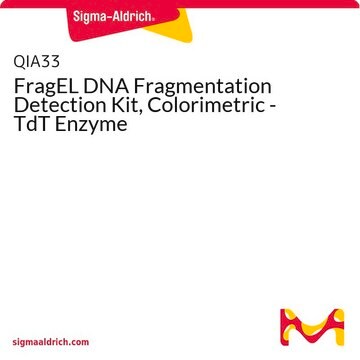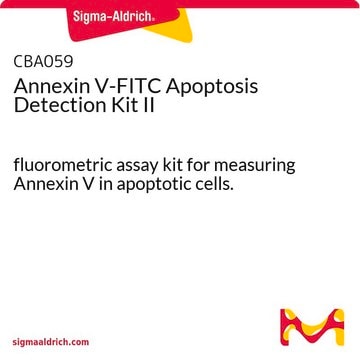APT110
Apo-Direct TUNEL Assay Kit
The APO-DIRECT Kit is a single-step staining method for labeling DNA breaks to detect apoptotic cells by flow cytometry.
Sinónimos:
Apoptosis detection kit, TUNEL apoptosis assay, TUNEL assay kit
Iniciar sesiónpara Ver la Fijación de precios por contrato y de la organización
About This Item
Código UNSPSC:
12161503
eCl@ss:
32161000
NACRES:
NA.84
Productos recomendados
Nivel de calidad
reactividad de especies
vertebrates
fabricante / nombre comercial
ApoDIRECT
Chemicon®
técnicas
flow cytometry: suitable
método de detección
fluorometric
Condiciones de envío
wet ice
Descripción general
The CHEMICON APO-DIRECT Kit is a single-step staining method for labeling DNA breaks to detect apoptotic cells by flow cytometry (Li et al. 1995). The kit contains all the reagents required for measuring apoptosis in cells including positive and negative control cells; washing, reaction, and rinsing buffers; and propidium iodide/RNase A solution for counter staining the total DNA.
Aplicación
Research Category
Apoptosis & Cancer
Apoptosis & Cancer
The APO-DIRECT Kit is a single-step staining method for labeling DNA breaks to detect apoptotic cells by flow cytometry.
Componentes
The following components are included with the APO-DIRECT Kit. Reagent bottles have color coded caps to aid in their identification. Sufficient reagents are provided to process 50 cell suspensions including control cells of approximately 1 x 106 cells per suspension for flow cytometry analysis. The control cells have been fixed as described (under the heading cell fixation procedure) and are in 70% (v/v) ethanol.
Positive Control Cells,Brown cap
Negative Control Cells, Natural cap
Wash Buffer, Blue cap
Reaction Buffer, Green cap
TdT Enzyme, Yellow cap
F-dUTP, Orange cap
Rinsing Buffer, Red cap
PI/RNase Staining Buffer, Amber bottle
Positive Control Cells,Brown cap
Negative Control Cells, Natural cap
Wash Buffer, Blue cap
Reaction Buffer, Green cap
TdT Enzyme, Yellow cap
F-dUTP, Orange cap
Rinsing Buffer, Red cap
PI/RNase Staining Buffer, Amber bottle
Almacenamiento y estabilidad
Precautions and Warnings:
1. The components of this kit are for Research Use only and are not intended for diagnostic procedures.
2. Positive and negative control cells contain 70% (v/v) ethanol as a preservative; wash and reaction buffer contain sodium cacodylate (dimethylarsinic) as a buffer; rinsing and PI/RNase staining buffer contain 0.05% (w/v) sodium azide as a preservative. These materials are harmful if swallowed; avoid areas of contact immediately. See Material Safety Data Sheets.
3. TdT Enzyme will not freeze at -20oC, because it is in 50% (v/v) glycerol solution. Upon warming the TdT enzyme solution, centrifuge the tube for 30 seconds to force all the liquid to the bottom of the tube.
1. The components of this kit are for Research Use only and are not intended for diagnostic procedures.
2. Positive and negative control cells contain 70% (v/v) ethanol as a preservative; wash and reaction buffer contain sodium cacodylate (dimethylarsinic) as a buffer; rinsing and PI/RNase staining buffer contain 0.05% (w/v) sodium azide as a preservative. These materials are harmful if swallowed; avoid areas of contact immediately. See Material Safety Data Sheets.
3. TdT Enzyme will not freeze at -20oC, because it is in 50% (v/v) glycerol solution. Upon warming the TdT enzyme solution, centrifuge the tube for 30 seconds to force all the liquid to the bottom of the tube.
Información legal
CHEMICON is a registered trademark of Merck KGaA, Darmstadt, Germany
Cláusula de descargo de responsabilidad
Unless otherwise stated in our catalog or other company documentation accompanying the product(s), our products are intended for research use only and are not to be used for any other purpose, which includes but is not limited to, unauthorized commercial uses, in vitro diagnostic uses, ex vivo or in vivo therapeutic uses or any type of consumption or application to humans or animals.
Palabra de señalización
Danger
Frases de peligro
Consejos de prudencia
Clasificaciones de peligro
Carc. 1B - Eye Irrit. 2 - Flam. Liq. 2 - Resp. Sens. 1
Código de clase de almacenamiento
3 - Flammable liquids
Punto de inflamabilidad (°F)
69.8 °F
Punto de inflamabilidad (°C)
21 °C
Certificados de análisis (COA)
Busque Certificados de análisis (COA) introduciendo el número de lote del producto. Los números de lote se encuentran en la etiqueta del producto después de las palabras «Lot» o «Batch»
¿Ya tiene este producto?
Encuentre la documentación para los productos que ha comprado recientemente en la Biblioteca de documentos.
Los clientes también vieron
Shu-Yi Lin et al.
Journal of the American Chemical Society, 132(24), 8309-8315 (2010-05-27)
Subnanometer photoluminescent gold quantum dots (GQDs) are functionalized with a peptide moiety that contains both nuclear export signal (NES) and nuclear localization signal (NLS) sequences. By taking advantage of its small size and great photostability, the functionalized GQDs are used
Farzana Shaheen et al.
Peptides, 106, 68-82 (2018-07-22)
The frog natural product temporin-SHa (FLSGIVGMLGKLFamide) is a potent antimicrobial peptide, as is the analog [S3K]SHa. By solid-phase synthesis, we prepared temporin-SHa and several temporin-SHa analogs with one or more D-alanine residues incorporated. The natural product and the analog [G10a]SHa
Supriya Sen et al.
Nature communications, 4, 1336-1336 (2013-01-10)
SR family RNA binding proteins regulate splicing of nascent RNAs in vitro but their physiological role in vivo is largely unexplored, as genetic deletion of many SR protein genes results in embryonic lethality. Here we show that SRSF3HKO mice carrying
Nan Cheng et al.
Frontiers in veterinary science, 7, 580530-580530 (2020-12-03)
Background: Canine mammary carcinoma is common in female dogs, and its poor prognosis remains a serious clinical challenge, especially in developing countries. Benzyl isothiocyanate (BITC) has attracted great interest because of its inhibitory effect against tumor activity. However, its effect
Xiaoyun Tang et al.
Journal of lipid research, 55(11), 2389-2400 (2014-09-12)
Lipid phosphate phosphatase-1 (LPP1) degrades lysophosphatidate (LPA) and attenuates receptor-mediated signaling. LPP1 expression is low in many cancer cells and tumors compared with normal tissues. It was hypothesized from studies with cultured cells that increasing LPP1 activity would decrease tumor
Nuestro equipo de científicos tiene experiencia en todas las áreas de investigación: Ciencias de la vida, Ciencia de los materiales, Síntesis química, Cromatografía, Analítica y muchas otras.
Póngase en contacto con el Servicio técnico












